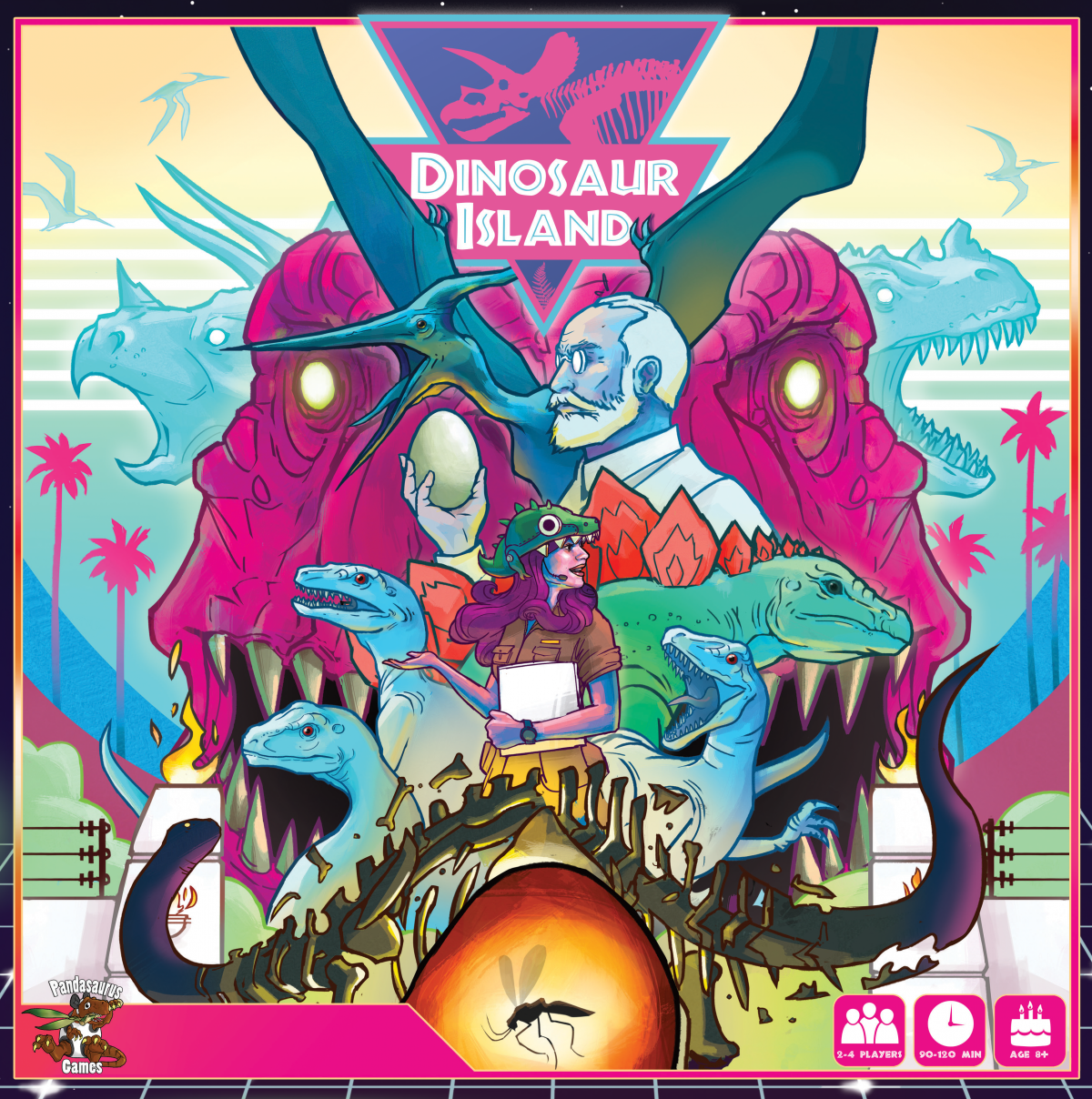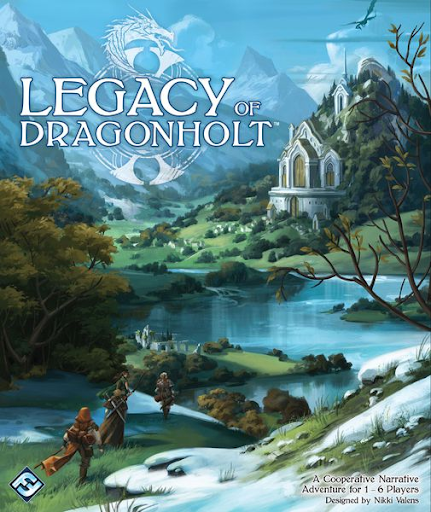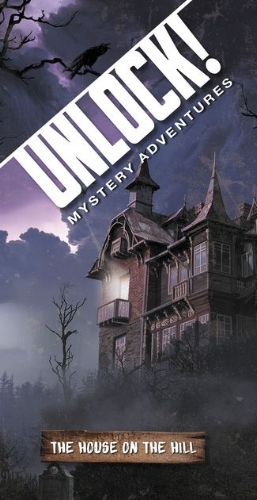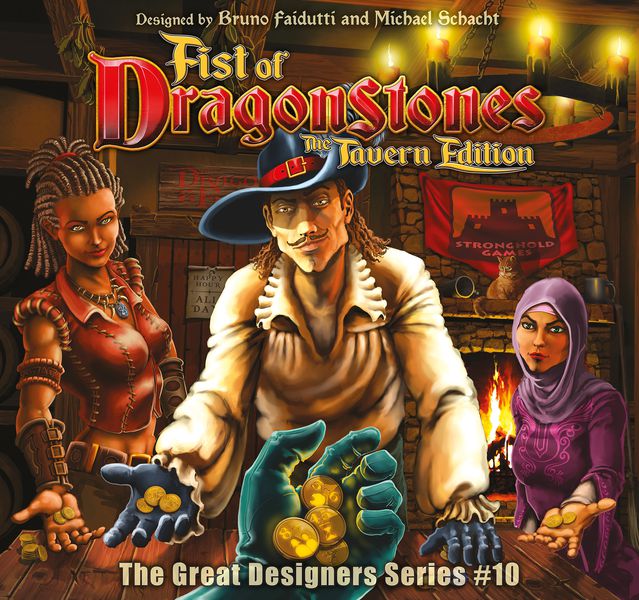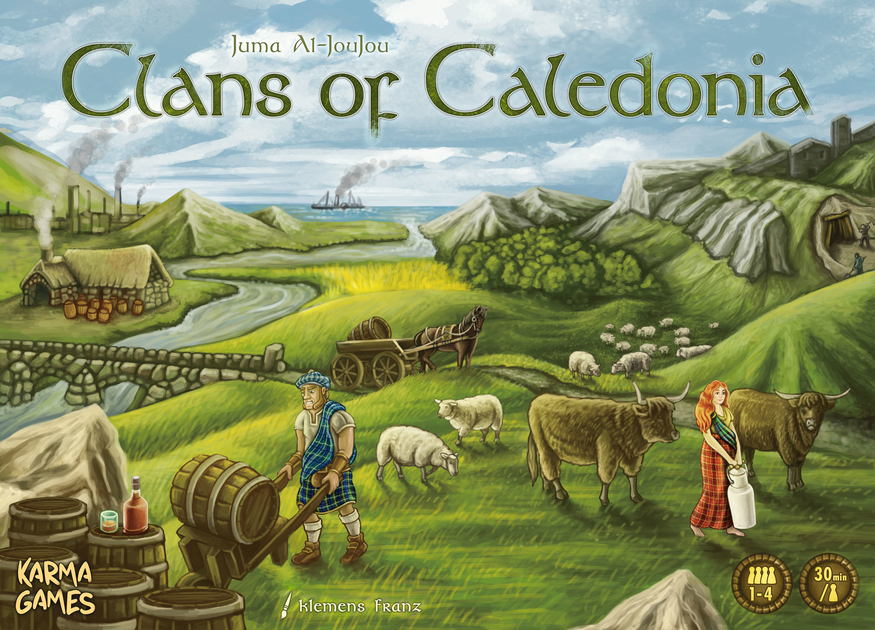Dinosaur Island
Designed by Jonathan Gilmore & Brian Lewis
Artwork by Kwanchai Moriya and Peter Wocken
Published by Pandasaurus Games - 2017
1-4 players ~ 90-120 minutes
Review by Josh Simons
Ladies and gentlemen, boys and girls; prepare to have… a T-Rex? You have a T-Rex? You can have a T-Rex. Welcome to Dinosaur Island! This is a land of corporate competition, embryonic research, and a balance of whether or not there’s enough salt to taste on your guests. The stars of your prehistoric park are hungry and the only thing that will stand between their stampeding appetites and patrons is your bottom line. You can’t have patrons dying in your park, because how can you get their cold hard cash if it’s digesting inside the gullet of a Spinosaurus? At least, that’s what I thought I was going to get.
Note to the reader: The version of Dinosaur Island presented in this review is the Deluxe Edition from Pandasaurus Games’ first Kickstarter campaign. Some of those components are exclusive to this Deluxe Edition, most notable of which are the metal coins and the dinosaur meeples. The majority of this review will focus on the general experience of Dinosaur Island, Deluxe Edition or not. So just to get the deluxe stuff out of the way, the coins are heavy and awesome and I love them, the deluxe-dinos come in a variety of sauro-shapes as opposed to the normal edition’s purely triceratops meeples, an additional VIP visitor type, and the first player token is, instead of a mosquito-in-amber token, a neon-nineties style slap bracelet, which is nicer than any slap bracelet than I remember from growing up in the nineties. If there’s one thing that can be said for this game, it’s that Pandasaurus was into the retro theme when they made it. It totally feels like a passion project, but not at the expense of a playable game. Though, some of the gears of this machine do feel a bit out of sync.
The boat to Dinosaur Island docked at the port of Isla TableTop in a flurry matrix of green and fuschia. The box art pulls at your curiosity with a combination of contrast and nostalgia. At first glance, it’s easy to surmise that Dinosaur Island is Jurassic Park: The Board Game. You wouldn’t be entirely wrong, but you wouldn’t be entirely right, either.
Dinosaur Island has more going on than DNA spinning in a laboratory centrifuge. Buckle up in your Land Rover, modern consumers of the prehistoric. Check your respect at the towering front gate; it’s coupon day.
A game of Dinosaur Island takes place over five phases. As opposed to getting up close and personal with the teeth of each phase, let’s view them from a safe distance. Before we begin the tour, each player gets two player boards. One is your lab where you keep track of your DNA cold storage and maintain the balance between your park’s threat level and security. The other player board is your actual park; think of this as your own little fossil farm where you need to feed your park security to keep its inhabitants from eating your people while they buy licensed tchotkes and snacks. You aren’t feeding your people; you’re keeping them from being fed on. Maybe.
In addition to your player boards, there are three common boards accessible to all players. One serves for a worker placement areas for your research scientists, while another is used to track player turn order, park excitement level, and victory points. The third is a marketplace for upgrading your laboratories contents or capacities, your parks attractions, your research benefits and capabilities, your parks workers, or your disposable currency.
Off hand, that seems like a lot, but the bottom line is that you’re trying to make your park more exciting so more people will come to it and give your their money, which will be used to invest in your park, hopefully gaining victory points from a variety of means before all but one of the variable game-length objectives have been completed. Phew. You’re going to have to balance more than just your security. It may seem like there is a lot to keep track of (which there is) so the best you can do is forecast and hope for the best; however, as the game progresses, viable strategies for success do emerge.
Game progression and strategy are shaken up from game to game. One of the features toted for Dinosaur Island is variable game length, adjusting between short, medium, and long. Each length set has a deck of cards that game-ending objectives will be selected from, and each set has a similar set of objectives but varying in number. Plot twist cards will also be selected prior to the beginning of the game. This is a cool mechanic which mixes up how each game is played, varying how you will approach your objectives from game to game.
Phases - “Hold Onto Your Butts”
Each of the 5 phases in Dinosaur Island will have you building off the previous one. It takes a lot of cranking to get this park engine going. While I would not call the process fluid, it is not completely unwieldy, either. In Phase 1, you’ll be allocating your research scientists to different tasks like improving your labs DNA cold storage, working up new dino recipes, extracting that sweet sweet dino DNA from rolling those amber DNA dice. You want theme? You’ve got theme. Having amber DNA dice is a really cool attention to detail, even if that emphasis is missed in some other areas. Watch out for any unused DNA from the available pool as that will cause a temporary increase in the threat level of each players park.
In Phase 2, it’s time to equip and improve the efficiency of your park engine. Here you’ll be able to add attractions to your park like rides or restaurants. Maybe you want to upgrade your facility to give you a no-cost security increase each round, or make it easier to produce a dinosaur that will call for that security need due to an increased threat level. Maybe you want to gain a worker or extra bonus to your park by hiring a specialist. If your cold storage is sparse, you can use some of your coin money to add some basic or advanced DNA to your storage with the added bonus of being able to sock it to your opponents by removing from the market that upgrade or specialist that they had their eye on. Not featured on the market board is the option to pass and collect $2. With all the other visual reminders, it’s likely that players may miss this option all together unless they just know the rule. How many times have you taught a game to players and said mid-game, “Oh! You can also do this.” How well is that received? Two rounds of market selections are taken for each player, and you’re on to the next phase.
Phase 3 brings full focus to the buttons and levers of your park. You are the one behind the mirrored glass, working out the technicalities of how your mad science abominations are brought forth, as well as the cages to contain them. During Phase 1, you may have been working the contents and capacities of your cold storage. During Phase 2, you may have upgraded the capabilities of your lab. In Phase 3, you can actually bring those dino recipes to meeple life, among other things. If you’ve upgraded your lab or hired specialists, those upgrades will show up here. This is your opportunity to increase paddock capacities, manipulate DNA, and keep your security level higher than the threat of your park-bominations, assuming you don’t want your paying guests to be eaten. Perhaps a few eaten guests are worth your end goal; you’ve planned for that unfortunate-for-them contingency.
Phase 4. You’ve worked hard to build your paddocks, build your attractions, build your dinosaur engine so that visitors will want to spend money at “Grand Theft Dino: Lost City”, (or whatever you’ve decided to refer to your park as). Your excitement level, which is hopefully increasing as the game progresses, will determine how many visitors come to your park. More exciting dinosaurs, which bring a higher threat level, will bring in more visitors. While most of these visitors will end up giving you their money to ooh and ahh at your collections of prehistoric monsters while munching on a snack they bought from one of your tongue-in-cheek themed food stands, some hooligans will sneak into the park to take up space without paying. This works by drawing a number of meeples out of a bag in the same number as your excitement level. Think of the game Orleans, but with only two meeple options - paying patrons or non-paying hooligans. What’s nice about the drawbag containing hooligans is that there are only a few of them in the bag. This creates some tension when drawing visitors. After all, these patrons line up outside your park and pay you $1 per person, but only if your park has space for them. The hooligans merely take up space that a paying customer could occupy.
Evaluate your threat versus security, and if there’s a gap in favor of the dinosaurs, then the clever girls will be eating your visitors at the Clever Grill. Whatever the gap is between threat and security determines how many visitors you’re going to lose out of your park, and you can better believe the non-paying hooligans are going to slip past the dinosaurs just as easily as they slipped past your front gate. The paying patrons get devoured first, which means that unless the gap in your security is quite wide, only the patrons will be eaten. For however many patrons are left in your park after “dinos on the loose” has been carried out, you’ll gain a victory point. In a nice moment of decision strategy, you have the option of collecting money from patrons at your restaurant locations instead of gaining the victory point. How are you going to tilt your gains from your restaurants to cater towards the future needs of your park?
Phase 5 is simply a cleanup phase, where the player turn order is determined by victory points, items are cleared and brought into the market, new dinosaur recipes are discovered, workers and scientists are returned to their queue on your lab board, visitors - patrons and hooligans alike - are returned to the draw bag, and plot twists are resolved. Plot twists are variable mechanics and bonuses, determined by a few cards from its particular deck at the beginning of the game, that are meant to increase the replayability of the game.
Also note that at the end of each phase, it should be determined if any players have met an objective. These objectives can only be completed once, so multiple players can only claim the same objective if they complete it during the same phase. When all but one objectives have been claimed, the end of the game is triggered.. Complete the final round, collect points from attractions, exhibits, completed objectives, and a pittance of points for your money supply. At 1VP for every $5 you have, it pays to invest that back into your park. It’s easy to overlook the final scoring rule that any paddock you built which does not contain any dinosaurs will cost a hefty 10VP from your final score. Whichever corporation has the highest number of victory points is the winner.
Components, Kickstarter, and Criticism
Let’s talk about these meeples first. One thing that was difficult for me to grasp on this game was that every meeple in the base game is a triceratops. The Deluxe Edition on Kickstarter sort of addressed this by offering multiple meeple shapes, but every dinosaur recipe was not represented with a corresponding meeple. In fact, some meeples, like the parasaurolophus, did not even have a dinosaur recipe. This felt like a thematic disconnect when I first encountered it. If my park wasn’t going to visually represent my dino-reality, why not simply have pink cubes? Now, having played Dinosaur Island, I see things from a different angle. Your park board doesn’t necessarily function as an exact representation of what’s in it, but in the same way many people within corporations feel like a number, each dinosaur is represented by a corporate logo: the pink triceratops. In this way, Dinosaur Island feels much more thematic in that you are building and controlling your own corporation trying to achieve its bottom line rather than a sprawling park focused on dinosaurs. In other words, you may find the theme of Dinosaur Island difficult if you approach it seeking the wonder of an archeologist rather than the greed of a blood-sucking lawyer.
This is where I feel like the game divorces from its inspiration material. If you came for Jurassic Park: The Game, and I don’t think it’s unreasonable to say that’s how Dinosaur Island comes across at first glance, it may come as a disappointment that the game is more about running a corporation that funds the whole operation. It has dinosaurs in it, but it’s not necessarily about dinosaurs. The bright colors of the graphic design invoke the time period of the 1990’s in America, where everything was eXtreme and in hypercolor. While this isn’t necessarily a negative to me as I see it trying to tap into one of the cultural themes of that era, I do, however, wish it felt more Jurassic than it did 90’s. When a patron gets eaten, there is little sense of loss or even a cost. It feels more tense that you might draw a hooligan from the bag than if you’re about to have a patron lost to a lapse in dinosaur security. The “dinos on the loose” mechanic being such a small part of the round is part of what disconnects the Dinosaur from the Island. Maybe if it didn’t so heavily rely on Jurassic Park as it’s inspiration I wouldn’t feel this way. I wanted at least part of it to feel like Ian Malcolm in the back of a Jeep saying, “Must go faster.” Instead, it’s merely a blip on the radar of going through the phases, and further reinforces the corporate preoccupation of whether or not we could instead of stopping to think if we should.
Your player board is christened with your corporation’s logo and is double cut so that table jostles don’t cause your DNA to come tumbling out of place before it’s ready to be refined. (These have yet to warp in my copy, which can be a problem with these type of boards sometimes.)
The game comes with a punch board of basic coins. These feel so chinzty and small that they’re more like credits than anything monetary. The Deluxe Edition did some with ultra chunky metal coins, which almost seemed to serve more like slammers as this edition also came with a punch board of pogs as a stretch goal. That’s an odd allocation of resources, in my opinion, but I guess it fed into that feel of American culture in the early 1990’s. Anyway, these coins were slimmed down in the later X-treme edition of the game as to not be so chunky. I actually like the heft of them in the Deluxe edition. As for the base gamers? Still getting those basic cardboard credits. If you lean more heavily towards mechanics than theme and components, this will not make any difference for you. For me, components can make or break a game as I like to experience the different weights and textures of them.
One of the features that was touted for Dinosaur Island is the variable game length. This feels like it was extracted from the game length idea used in Dead of Winter, but it is not scenario based. The short game is helpful as a learning game, but feels almost worthless after that. Both the short and medium games give you the experience of almost getting and engine up and running but without any payoff. The long game is where your park can really get going. Personally I would have rather seen the short game utilized specifically as a “learn to play” game, and the rest of the short and medium game cards refined into the long game for greater variability. The short or partial game idea has been used in games like Charterstone and Hail Hydra as a successful learning tool, whereas Dinosaur Island has it as an unsatisfying bite size version of a game if you only have a short amount of time to play. If that’s truly the case, your setup is going to eat that time up, anyway.
Now with three different editions of the game released (two Kickstarter exclusives and one base retail), in addition to the standalone two-player Duelosaur Island, it seems like there were so many ideas that the creators wanted to be put into the game. Perhaps too many. A few things probably could have been left on the cutting room floor to deliver a more consistent experience, while some more functional graphic design (like the lack of a $2 pass reference on the market board) would have been helpful. The flow of the game can feel clunky from phase to phase, sections of the rulebook, such as green, one-time bonuses are unclear, and for a game with so much iconography, the lack of quick reference sheets is perplexing. After several games, Dinosaur Island never felt intuitive, in spite of the relatively low complexity of decision making in the game.
Flash In The Pan or Evergreen?
Unfortunately for Dinosaur Island, I learned to play it the same week that I learned to play the masterful Caverna, which colored my experience with the game. Dinosaur Island has so many cool, trendy, cutting edge elements, but every time I play it I think to myself, “I could have been playing Caverna.” I’m just not sure it has the staying power I want from a game because I’ve never been left thinking about how I could play it better next time.
Ultimately, Dinosaur Island’s cohesiveness and finesse does not live up to the grandeur of its concepts. It feels like a pink triceratops indulging in a bowl of pistachio ice cream topped with jelly beans, licorice, sprinkles, gummy bears, strawberry syrup, and marshmallows. It’s sweet at first, but Dinosaur Island is not a park I would want a season pass to.
Other recent written reviews:

